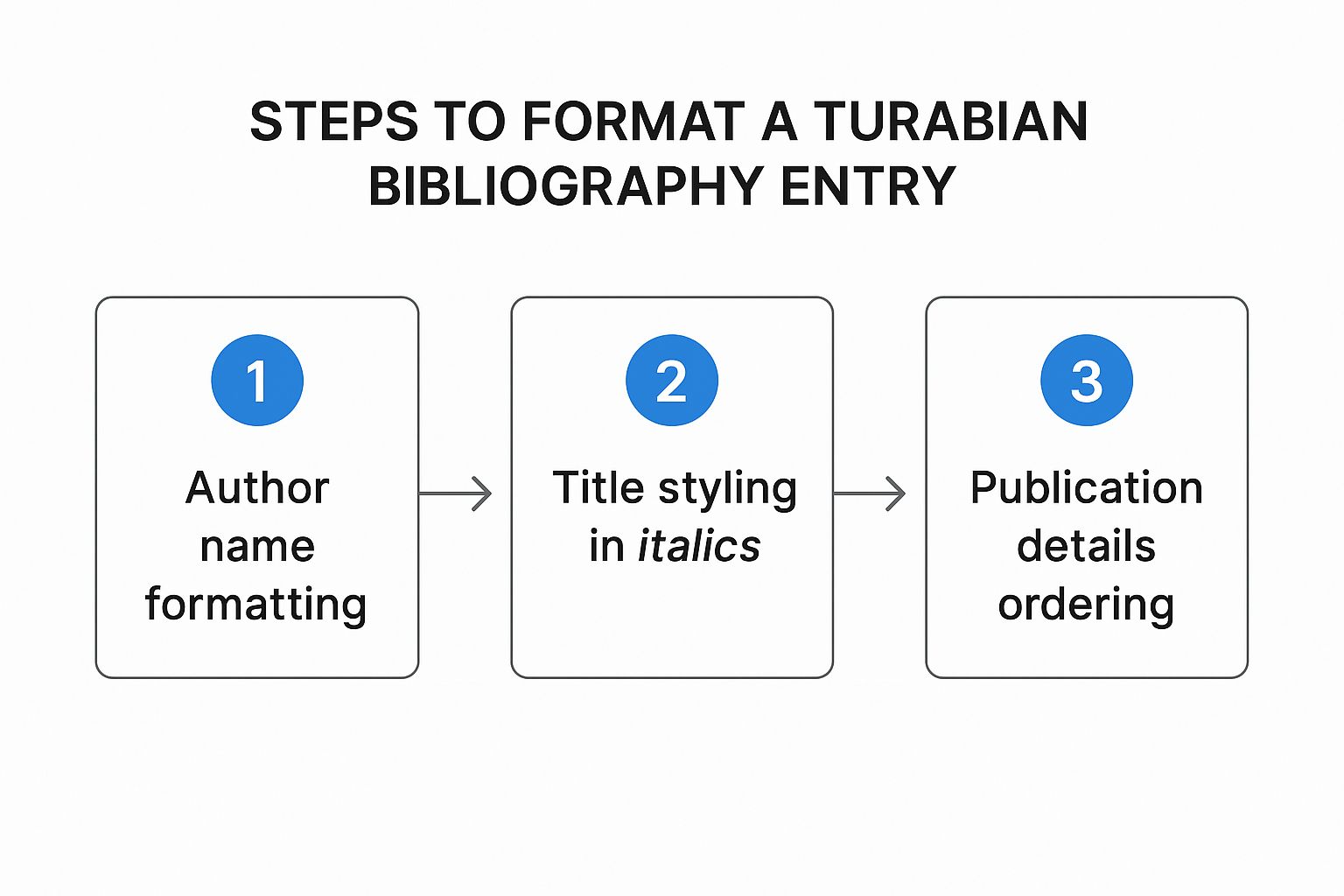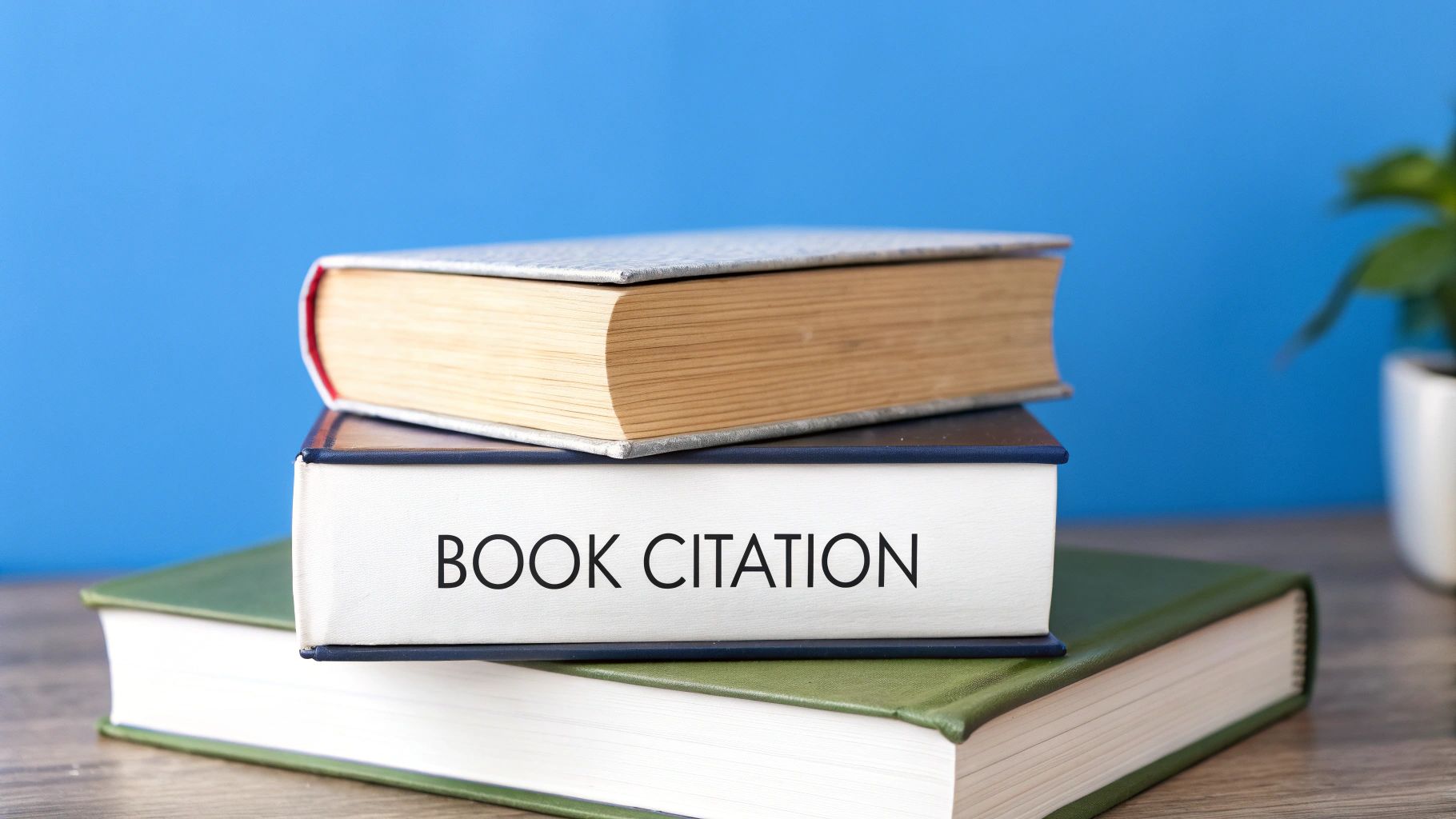Understanding Turabian Citation Fundamentals (And Why It Matters)

Academic writing comes with its own set of conventions, and citation styles form a fundamental part of this structure. Among these, the Turabian citation style stands out, particularly for students seeking to present their work in a scholarly manner. This system, created by Kate L. Turabian, is a widely accepted standard for documenting research, especially within humanities fields.
Turabian's popularity stems from its practical design. It is built upon the comprehensive Chicago Manual of Style, yet it's specifically modified for students and researchers, making it easier to use while maintaining academic credibility. The 9th edition of Turabian's guide emphasizes the Notes-Bibliography Style.
This style uses superscript numbers within the text, which correspond to footnotes or endnotes containing the full citation information. This approach is particularly useful for papers with numerous sources, as it allows readers to easily locate a bibliography Turabian example without interrupting their reading. Many academic institutions suggest Turabian due to this clarity and effective organization. For a deeper look at how it's used, you can find more information on Turabian application at FIU Libraries.
Why Turabian Gives You an Edge
Learning Turabian is more than just adhering to a set of rules; it's a way to present your academic work with professionalism. Many professors prefer this style because it signals a student's meticulousness and dedication to academic honesty. Clear and accurate citations foster trust with your audience, enabling them to concentrate on your arguments instead of being sidetracked by unclear referencing.
Familiarity with Turabian also involves understanding its unique characteristics when compared to other citation formats like MLA or APA. Although the main goal of citing sources is the same across all styles, Turabian provides particular instructions for structuring footnotes, endnotes, and the bibliography. It's important to understand these specific details, such as how to correctly format a bibliography Turabian example for different source types, like a book versus a website.
Turabian vs. Chicago: Clearing the Confusion
Many wonder about the connection between Turabian and the Chicago Manual of Style (CMOS). Essentially, Turabian can be seen as a version of CMOS that is specifically geared towards students. The CMOS is the exhaustive guide for professional publishers and scholars.
In contrast, Turabian, whose full title is A Manual for Writers of Research Papers, Theses, and Dissertations, presents a curated set of rules from CMOS that are most applicable to student papers and research projects.
So, when you use Turabian for your citations, you are effectively applying the principles of the Chicago style. This relationship means that learning Turabian equips you with a strong basis for more advanced academic or professional writing situations where strict adherence to the complete CMOS might be necessary. This understanding will help you confidently format any bibliography Turabian example required for your assignments.
Your Step-By-Step Bibliography Creation Blueprint
Putting together a bibliography might seem like the last tough step in a long academic journey. However, with a solid plan, creating a bibliography Turabian example that meets all requirements can be quite manageable. This section offers a practical guide to help you succeed with your citations, from the initial stage of collecting sources to producing a polished final list.

The infographic above clearly shows the basic method for putting together a Turabian bibliography entry, dividing it into three main stages. It highlights the need for precise author name formatting, proper title styling (often using italics), and the correct sequence of publication details. Getting these fundamental elements right is essential for any accurate bibliography Turabian example.
Starting Strong: Gathering Your Source Information
The path to an impeccable bibliography starts as soon as you identify your first source. Keeping detailed records right from the start is absolutely key. For each source, ensure you note down all critical information:
- Author(s)/Editor(s) names
- Full title and any subtitle
- Publication city and publisher (for books)
- Journal title, volume, issue, and page numbers (for articles)
- URL and date of access (for online sources)
- Publication date
Consider this initial phase similar to mapping out a significant undertaking. For example, if you were aiming to create a working website, you would begin with a definite outline, possibly using a website design brief template to establish objectives and framework. In the same way, well-organized source details form the foundation for a bibliography free of errors.
Formatting Essentials: The Core of Your Turabian Bibliography
After collecting all your information, the next step is to format it following Turabian guidelines. Instructors look for consistency and precision in how every piece of information is presented. This involves careful attention to punctuation, capitalization (Turabian generally uses headline-style capitalization for titles in bibliographies), and the use of italics.
Key formatting aspects frequently include:
- Author names: For the first author, the last name comes first.
- Titles: Titles of books and journals are typically italicized. Titles of articles and chapters are generally enclosed in quotation marks.
- Alphabetical order: All entries in the bibliography should be arranged alphabetically according to the author's last name.
Paying close attention to these details showcases your commitment to academic standards.
To help you navigate the specifics, the table below outlines the essential components for various common source types in a Turabian bibliography.
Turabian Bibliography Elements by Source Type
Essential components required for different types of sources in Turabian bibliography format
| Source Type | Required Elements | Example Format (Simplified) | Common Errors |
|---|---|---|---|
| Book (One Author) | Author's Full Name (Last, First), Full Title of Book, Publication City: Publisher, Year. | Doe, John. The Art of Writing Well. New York: Academic Press, 2023. | Incorrect author name order; Missing publication city or publisher; Title not italicized. |
| Journal Article | Author's Full Name (Last, First), "Title of Article," Title of Journal Volume Number, no. Issue Number (Year): Page Range. | Smith, Jane. "Research Methods in History." Journal of Historical Studies 25, no. 2 (2023): 115-130. | Article title not in quotes; Journal title not italicized; Missing volume, issue, or page numbers. |
| Website | Author's Full Name (if available), "Title of Web Page," Title of Website, Publication or Last Modified Date, URL. Accessed Date (if no pub/mod date). | Public, John Q. "Digital Citation Guide." Online Writing Lab. Last modified July 15, 2023. https://example.com/citation. | Missing access date when no publication date is available; URL not complete; Website title not italicized. |
| Chapter in an Edited Book | Author's Full Name (Last, First), "Title of Chapter," in Title of Book, edited by Editor's Name(s), Page Range of Chapter. Publication City: Publisher, Year. | Brown, Michael. "The Impact of Technology." In Modern Society, edited by Emily White and David Green, 45-67. Chicago: University Press, 2023. | "In" missing before book title; Editor names not properly formatted; Page range incorrect or missing. |
This table provides a quick reference for some of the most common source types you'll encounter. Always double-check specific requirements if you're unsure.
Tackling Tricky Sources with Confidence
Academic work often draws from a wider array of materials than just books and journal articles. You may find yourself needing to cite websites, blog entries, interviews, or even multimedia items. For instance, if you are citing a blog post in a bibliography Turabian example (if your instructor allows or if the blog is a reputable, consistent source), you would typically list the author, post title, blog name (often italicized as the larger publication), date, and URL.
The precise formatting can differ, so referring to the latest edition of Kate L. Turabian's A Manual for Writers or dependable university writing guides is always a good idea for these specific situations. This careful approach helps avoid last-minute formatting stress and ensures your work maintains its credibility, no matter the type of source.
Real Bibliography Examples That Actually Work

Often, the clearest path to grasping the details of any citation style is to see well-structured examples. This section offers practical bibliography Turabian example entries for frequently used source types. We'll point out the specific formatting details that ensure their accuracy.
These aren't just theoretical models; they are working examples you can use as a guide for your own research. We’ve also included notes to explain why particular components are essential for correct formatting.
The Foundational Format: Citing a Book
Books serve as a bedrock for much academic work, making their citation format a core skill. A standard bibliography Turabian example for a book will always feature the author's name, the book's title, and its publication information.
Here’s what that looks like:
- Example:
Pollan, Michael. The Omnivore’s Dilemma: A Natural History of Four Meals. New York: Penguin, 2006.
Let's look at the key elements that make up this citation:
- Author: The format is Last Name, First Name. (e.g., Pollan, Michael.).
- Title: You'll need the Full Title of the Book, Italicized, and in Title Case. (e.g., The Omnivore’s Dilemma: A Natural History of Four Meals.).
- Publication Information: This includes the Publication City: Publisher, Year. (e.g., New York: Penguin, 2006.).
- Punctuation: Pay close attention to the periods after the author's name, the title, and the year. A colon is used between the city of publication and the publisher's name.
A frequent error involves incorrect capitalization of the title or forgetting to put it in italics. While these might seem like minor points, they are significant for maintaining accurate Turabian style.
Navigating the Web: Citing Online Articles and Blogs
With digital materials becoming more common in research, knowing how to cite them is essential. For a bibliography Turabian example involving a website or online article, the goal is to provide enough detail for your reader to locate the source easily.
Consider this website example:
- Website Example:
Public, John Q. "Digital Citation Guide." Online Writing Lab. Last modified July 15, 2023. https://example.com/citation.
Here’s a breakdown of the essential components for a website citation:
- Author: Include the author's full name if it's provided.
- Page Title: The "Title of Web Page" should be in quotation marks.
- Website Title: The Title of Website should be italicized.
- Date: Use the publication date or the date it was last modified (e.g., July 15, 2023). If neither is available, provide an access date.
- URL: The complete web address is necessary.
When it comes to blog posts, the Turabian style, which is closely related to The Chicago Manual of Style, often recommends citing them in notes instead of the main bibliography. However, if a bibliography entry is needed, perhaps because the blog is cited often, the format mirrors that of other online materials.
Here’s an example for a blog post:
- Blog Post Example:
Saller, Carol. “Formatting Text Messages in Fiction.” CMOS Shop Talk (blog), March 10, 2020. https://cmosshoptalk.com/2020/03/10/formatting-text-messages-in-fiction/.
For blog posts, the key details are:
- Author: Use the author's name as it is displayed.
- Post Title: The "Title of the Post" goes in quotation marks.
- Blog Name: The Name of the Blog should be in italics. It's helpful to add "(blog)" if the name itself doesn't make this clear.
- Date: The date the post was published (e.g., March 10, 2020).
- URL: The direct link to the specific post.
A common mistake with online sources is leaving out the URL or failing to include an access date when a publication date can't be found. Providing these details is crucial for source retrievability.
Journal Articles: A Scholarly Staple
Academic journal articles are mainstays in scholarly writing, and their Turabian bibliography entries require a precise structure, including volume, issue, and page numbers.
Take a look at this example:
- Example:
Smith, Jane. "Research Methods in History." Journal of Historical Studies 25, no. 2 (2023): 115-130.
The core components for a journal article citation are:
- Author: Formatted as Last Name, First Name.
- Article Title: The "Title of Article" should be enclosed in quotation marks.
- Journal Title: The Title of Journal must be italicized.
- Publication Details: This includes the Volume Number, followed by "no." and the Issue Number, then the (Year): and finally the Page Range. (e.g., 25, no. 2 (2023): 115-130.).
Getting the punctuation and the sequence of volume, issue, year, and page numbers right is absolutely vital for a correct bibliography Turabian example of a journal article. These examples should give you a strong starting point for citing your own sources with accuracy and assurance.
Smart Tools That Make Citation Effortless
Manually putting together a bibliography Turabian example can be a lengthy and often frustrating task in academic writing. Fortunately, a range of smart tools are now available to manage much of this detailed work. This allows students to focus more on their research and less on the minutiae of punctuation and style guidelines. These digital aids are designed to help achieve Turabian accuracy with significantly reduced effort.
Exploring Citation Management Software
One of the most effective categories of these tools is citation management software. These programs act much like a personal digital librarian, helping you to:
- Collect and store all your research sources in one central place.
- Organize sources using tags, folders, and notes.
- Automatically generate citations and bibliographies in different styles, including Turabian.
Popular options can integrate directly with word processors. This integration makes the process of inserting footnotes and creating a final bibliography almost seamless, which is a major time-saver when dealing with numerous sources for your bibliography Turabian example.
The importance of correct citation cannot be overstated. Statistically, using citation styles like Turabian and Chicago properly can greatly influence the credibility of academic papers. A study by the Emory University Library highlighted how crucial proper citation is for maintaining academic integrity and trust with readers. The study noted that tools such as Zbib can help create accurate citations in Turabian style, which is vital for ensuring sources are properly acknowledged. This is especially important in fields like business research, where precise data and source attribution are key to the validity of findings. As of 2022, there has been an increasing adoption of digital tools to make the citation process easier for researchers. You can explore this topic further for more details on citation guides.
Browser Extensions for Quick Source Capture
Beyond comprehensive management software, browser extensions offer a speedy way to capture source information as you find it online. With a single click, these extensions can often pull essential details like author, title, publication date, and URL directly from a webpage, saving you from manual data entry. This instant capture feature is invaluable for efficiently building your source list. Many of these extensions can then send this information directly to your preferred citation management software, creating a smooth workflow for your bibliography Turabian example.
You might be interested in: How to generate citations effortlessly with our tool.
The Crucial Step: Double-Checking Automated Citations
While these tools offer fantastic support, it is vital to remember they are not perfect. Automated systems can sometimes misinterpret data or miss specific nuances required by Turabian style, especially for less common source types. Always double-check every automatically generated bibliography Turabian example against a reliable style guide or your professor's specific instructions.
Here are a few tips for ensuring professor-level accuracy:
- Compare the tool's output with examples from Turabian's manual.
- Verify that all required elements for each source type are present.
- Pay close attention to punctuation, capitalization, and italics.
Taking this final review step ensures your bibliography is polished and credible, reflecting the hard work you've put into your research. Ultimately, finding the right mix of tools that suits your research style and academic demands, paired with diligent checking, will make creating your next bibliography Turabian example much less daunting and significantly more accurate.
Mastering Complex Sources And Special Situations

While standard citation templates work well for many common sources, academic research frequently turns up items that don't fit neatly into these basic formats. This is where well-developed citation skills truly matter, allowing you to correctly document sources with multiple authors, missing publication details, government documents, and other unusual source formats. Learning how to manage these variations ensures your bibliography Turabian example entries are clear and credible, no matter how complex your research materials get. These advanced practices are important for showing thorough scholarly work.
Navigating Entries with Multiple Authors
When a source involves more than one author, Turabian style provides specific instructions for how they should appear in your bibliography. For a work by two or three authors, you will list all of them. The first author's name is inverted (Last Name, First Name), while any subsequent authors are listed in First Name Last Name order, with "and" placed before the final author's name.
- Example (Two Authors): Smith, John, and Jane Doe. Title of Work.
If a source has four to ten authors, all names are generally listed in the bibliography using a similar format. In the notes, however, you would typically list only the first author followed by "et al." For sources with more than ten authors, bibliography entries also usually list only the first author followed by "et al.", although some instructors or publications may prefer all names to be listed. Always refer to the most current Turabian guide or your instructor's preferences when dealing with works by numerous authors.
When Essential Information Is Missing
It's not uncommon to find sources that lack some standard publication information. If you cannot identify an author, the citation entry will begin with the title of the work. If a publication date is unavailable, use the abbreviation "n.d." (which stands for "no date") where the year would typically appear.
For instance, if a book does not list a publisher or place of publication, you might use an abbreviation such as "n.p." (meaning "no place," or "no publisher" if the context makes it clear, or you can spell out "No publisher"). A bibliography Turabian example for a book with no publication date would appear as:
- Doe, John. Title of Work. New York: Academic Press, n.d.
Knowing how to properly document sources even when they have missing information shows a careful and complete approach to your research. To help manage the citation process and keep research notes orderly, some find resources like these best blogging tools helpful, as good organization can make it easier to track down challenging source details.
Citing Unique and Governmental Sources
Beyond common books and articles, your research may involve specialized materials that need careful handling in your bibliography. Each type of source comes with its own particular formatting conventions.
- Government Documents: These often list the specific government body or agency as the author. You should include any available report numbers or series information. As an illustration, a bibliography Turabian example might begin with "U.S. Department of Health and Human Services."
- Different Editions and Translations: If you are using an edition of a work other than the first, this must be indicated (e.g., "2nd ed.," "Rev. ed.") after the title. For works that have been translated, the translator's name is also included, typically following the title with the phrase "Translated by [Translator's Name]."
- Archival Materials: When citing unpublished manuscripts or documents from archives, you need to provide details about the specific item, the author (if known), the date (if known), the name of the collection, and the repository (the archive or library) where the material is housed. Consistency in these complex citations is paramount for clarity and accuracy.
These more advanced formatting requirements are often encountered in serious academic projects. Learning these specific rules for various source types is essential for producing a thorough and correct bibliography. This careful attention to detail ensures your research aligns with high scholarly standards.
Error-Proof Your Bibliography Before Submission
Submitting academic work peppered with citation errors can unfortunately cast a shadow on even the most insightful research. A meticulously prepared bibliography, on the other hand, clearly demonstrates your attention to detail and respect for scholarly standards. This guide offers a quality control approach to help you ensure every bibliography Turabian example you prepare meets these high academic expectations.
Common Pitfalls in Turabian Bibliographies
Even the most careful students can sometimes overlook small mistakes that, when accumulated, become noticeable. Professors often spot subtle punctuation issues, such as a misplaced comma or an incorrect period, which might suggest a lack of thoroughness. More significant are major structural problems. These include errors like improperly formatted author names or inconsistent capitalization in titles, which can make your bibliography confusing and difficult for others to use. Such problems can unintentionally lower the perceived quality of your overall work.
Another area requiring close attention is maintaining perfect consistency, particularly when your bibliography contains numerous sources. It's crucial to be meticulous when, for instance, switching between using italics for book titles and quotation marks for article titles. Ensuring every entry in a bibliography Turabian example strictly adheres to the prescribed order of elements is also vital. These fine points are what separate a merely adequate bibliography from an excellent one.
Developing Your Foolproof Review System
The key to a flawless bibliography is moving beyond a quick final glance to a systematic review process. This involves adopting a structured method to identify and correct errors before your work is submitted. Cultivating a keen eye for citation accuracy develops with practice and a clear, methodical approach.
Consider putting these review steps into action:
- Element-by-Element Check: Carefully examine each citation, verifying author names, titles, publication details, and dates against the official Turabian guidelines.
- Punctuation Scan: Specifically look for the correct application of periods, commas, colons, and parentheses as required by the style.
- Formatting Consistency: Ensure that italics, quotation marks, and capitalization (specifically headline style capitalization for titles in the bibliography) are applied uniformly across all similar entries.
- Alphabetical Order Verification: Double-check that all entries are correctly alphabetized according to the author's last name.
- Cross-Reference with Notes: If you are using footnotes or endnotes, confirm that they accurately correspond with the entries in your bibliography.
For more help during this review stage, you might find resources on refining academic writing useful. You can explore our guide on how to ensure your content is polished and ready for further tips on comprehensive checking. This structured method makes reviewing any bibliography Turabian example a much more reliable task.
The Ultimate Quality Control Checklist
To really solidify your review process, a dedicated checklist can be an extremely helpful tool. Such a list guides you to systematically verify every crucial component of your Turabian bibliography, leaving less room for error.
Below is a detailed checklist designed to help you catch common mistakes.
Turabian Bibliography Quality Control Checklist
Systematic review process to ensure perfect Turabian formatting and avoid common errors
| Check Category | Specific Items | Red Flags | Quick Fix |
|---|---|---|---|
| Author Names | Correct order (Last, First); All authors listed per style; Accurate spelling | First name first for lead author; "Et al." used incorrectly; Misspelled names | Reorder names; Consult Turabian manual for multi-author rules; Verify spelling against the original source |
| Titles | Headline-style capitalization; Correct use of italics vs. quotation marks | Sentence-case capitalization for book titles; Missing italics/quotes; Inconsistent style | Apply headline capitalization; Ensure books/journals are italicized, articles/chapters are in quotes |
| Publication Info | City, publisher, year present (for books); Volume, issue, pages (for articles) | Missing elements; Incorrect order of elements | Add missing details; Reorder according to Turabian format (e.g., City: Publisher, Year.) |
| Punctuation | Periods, commas, colons used correctly; Parentheses for year in some contexts | Missing terminal periods; Commas instead of colons (or vice-versa) | Review each punctuation mark; Refer to a correct bibliography Turabian example for placement |
| Alphabetization | Entries correctly sorted alphabetically by author's last name | Entries out of order; Sorting by first name | Manually re-sort or use a software sort function, then carefully verify the order |
| Overall Consistency | Uniform formatting applied to all entries of the same source type | Variations in formatting for similar sources (e.g., some websites with access dates, others not) | Choose a consistent approach for elements like access dates (especially if publication date is missing) and apply it globally |
By consistently applying these checks, you ensure your bibliography is not just accurate but also stands as a testament to the thoroughness and high quality of your academic research. This attention to detail will be appreciated.
Key Takeaways For Citation Success
Turning bibliography creation from a difficult task into a manageable one is definitely possible. Getting good at making an accurate bibliography Turabian example comes down to knowing the main ideas and using established methods consistently. This guide outlines the key points for your citation success.
Core Principles for Every Bibliography Turabian Example
A few basic ideas are crucial for every properly made Turabian bibliography. Using these will greatly improve the quality and trustworthiness of your academic writing.
- Precision is Paramount: In Turabian style, every detail, such as punctuation and the order of information, is important. Aim for complete accuracy in each citation.
- Consistency is Key: Apply formatting rules the same way across all your citations. An inconsistent bibliography Turabian example can confuse readers and make your work look less professional.
- The Manual is Your Guide: If you're ever unsure, always look at the latest edition of Kate L. Turabian's A Manual for Writers or trusted university style guides.
Essential Techniques Revisited
In addition to these principles, certain practices will make your citation process smoother and help you steer clear of common mistakes. These methods are fundamental for efficient bibliography creation.
- Start Early, Record Diligently: Begin collecting and noting source information as soon as you start your research. This early effort helps prevent last-minute rushes and forgotten details.
- Use Tools Wisely: You can use citation management software and online generators to help with formatting, but always critically review what they produce to ensure it is accurate.
- Proofread with Purpose: Make time to specifically check your bibliography for errors. A final, focused review can catch mistakes that might have been missed otherwise.
Building Confidence in Citation
Becoming skilled in Turabian citation is about more than just learning rules; it's about feeling confident in your academic presentation. Each correctly formatted bibliography Turabian example you complete builds your understanding and demonstrates your commitment to academic honesty. Remember that this skill helps your research make a bigger impact. For students who want to further improve their writing, you might find these Tips for generating well-structured essays helpful. With practice and by paying attention to these key points, you'll be well-prepared to face any citation challenge.
Ready to improve your academic writing and ensure your citations are always correct? Discover how SmartStudi’s range of AI-powered tools, including our precise citation generator and text humanizer, can assist your success. Visit SmartStudi today and reduce the stress in your student life!
